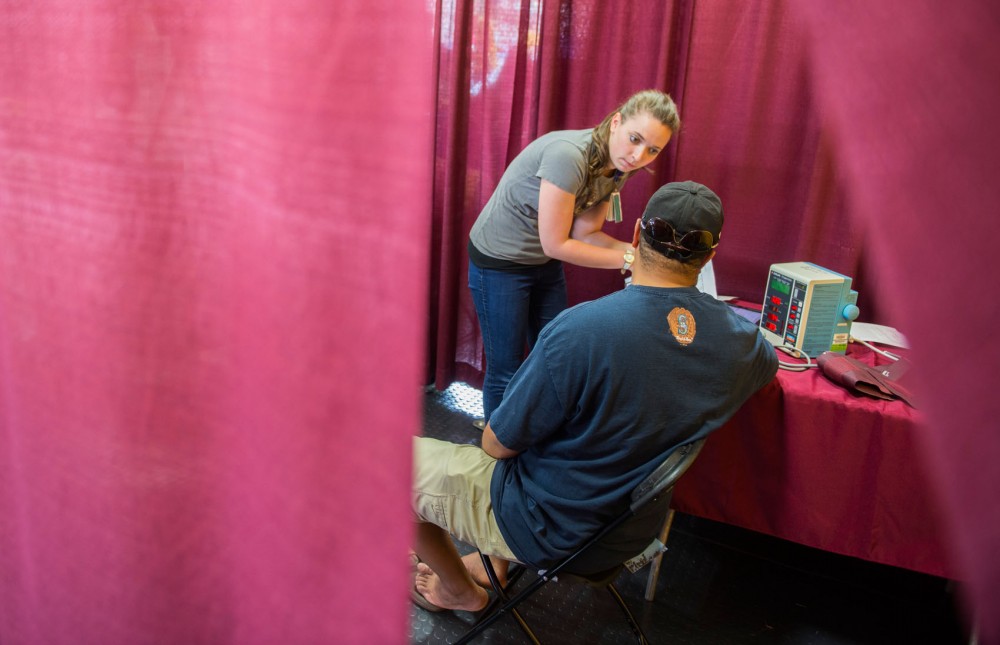Amid the Minnesota State Fair’s grease-battered cheese curds and corndogs, University of Minnesota researchers scooped attendees for studies.
During the fair’s 12 days, its former Spamville exhibit became an unlikely hotspot for more than 30 research projects claiming alternating spots at the site’s new Driven to Discover research building.
Researchers said the open clinic format gave them access to a vast pool of volunteers — a resource many said they normally couldn’t count on.
Researchers often rely on posting fliers around campus to attract volunteers, associate pediatrics professor Logan Spector said, which can distort findings when mostly educated young people respond.
“It turns out we tapped into a wide faculty demand,” Spector said. “We get a broader cross-section of Minnesotans here [at the fair].”
Sarah Schellinger, a speech, language and hearing sciences doctoral student, has relied on fliers to draw subjects in the past.
“It’s hard to find participants when you’re sitting in your lab,” she said. “[The fair] is a great forum for people to come in, see what’s going on at the ‘U,’ and they can participate in whatever looks interesting to them.”
The studies mainly focused on improving human health and safety, but spanned subjects from entrepreneurship and psychology to health sciences.
One study asked for people of all ages to pout, smile and snarl for photos that researchers will use to understand how children process emotions. In other studies, participants took the wheel in a distracted driving simulator or had their hands swabbed for bacteria.
And they all lasted less than half an hour.
In 2010, Spector, along with associate epidemiology professor Ellen Demerath, launched the Gopher Kids Study at the State Fair.
Over the course of six days, the study enrolled 841 children in an effort to track the genetics of their growth — far exceeding its goal of 500 participants.
Spector said that trial was so successful that he and Demerath decided to open it to other projects. They quickly found University researchers eager to join in.
Last week, associate law professor Francis Shen recruited fairgoers for a mock jury at his booth.
His study, which examines factors that influence court decisions, required a sample that would reflect the makeup of a real jury. The State Fair provides an ideal pool of volunteers that closely mirrors the general population, Shen said.
“We can only offer so much compensation, so it often isn’t worth their time to come to the Law School,” Shen said. “Here the fair brings the people to us.”
Between getting their faces painted and scoping out the fair’s 300 food booths last week, Shakopee resident Carrie Toward and her 9-year-old son Linus took part in a beverage survey.
“There was a lady who asked if we had a kid a certain age, and we just jumped in,” Toward said, adding that researchers were upfront about their purpose and that she would gladly take part in future University studies at the fair.
Betsy Handlson, a retired University administrative director, took part in two studies last week. As a passionate fairgoer, Handlson said, she thought it was smart for the school to conduct studies out in the open at the State Fair.
“It’s always good to see them doing good, pertinent research,” she said.
The Office of the Vice President for Research covered half of the building’s $150,000 cost. The University’s Medical School, the School of Public Health and the College of Food, Agricultural and Natural Resource Sciences provided the remaining funds.
This year, the funds covered rent, building upgrades and Internet service, among other costs, providing a valuable economic resource for University researchers as well, Spector said.
“If you can meet your sample requirement during 12 days at the fair, that’s going to be a lot cheaper than keeping a study staff going for a trickle of enrollment throughout the year,” he said.
Spector, who expected a turnout of well over 10,000 participants by the fair’s end, said he hopes to make the Driven to Discover building a permanent facility. But if word gets around, he said, higher demand may require more space.

















